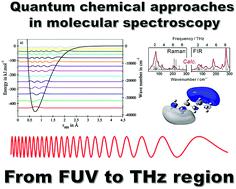当前位置:
X-MOL 学术
›
Chem. Soc. Rev.
›
论文详情
Our official English website, www.x-mol.net, welcomes your feedback! (Note: you will need to create a separate account there.)
Advances, challenges and perspectives of quantum chemical approaches in molecular spectroscopy of the condensed phase
Chemical Society Reviews ( IF 46.2 ) Pub Date : 2021-08-12 , DOI: 10.1039/d0cs01602k Yukihiro Ozaki 1, 2 , Krzysztof B Beć 3 , Yusuke Morisawa 4 , Shigeki Yamamoto 5 , Ichiro Tanabe 6 , Christian W Huck 3 , Thomas S Hofer 7
Chemical Society Reviews ( IF 46.2 ) Pub Date : 2021-08-12 , DOI: 10.1039/d0cs01602k Yukihiro Ozaki 1, 2 , Krzysztof B Beć 3 , Yusuke Morisawa 4 , Shigeki Yamamoto 5 , Ichiro Tanabe 6 , Christian W Huck 3 , Thomas S Hofer 7
Affiliation

|
The purpose of this review is to demonstrate advances, challenges and perspectives of quantum chemical approaches in molecular spectroscopy of the condensed phase. Molecular spectroscopy, particularly vibrational spectroscopy and electronic spectroscopy, has been used extensively for a wide range of areas of chemical sciences and materials science as well as nano- and biosciences because it provides valuable information about structure, functions, and reactions of molecules. In the meantime, quantum chemical approaches play crucial roles in the spectral analysis. They also yield important knowledge about molecular and electronic structures as well as electronic transitions. The combination of spectroscopic approaches and quantum chemical calculations is a powerful tool for science, in general. Thus, our article, which treats various spectroscopy and quantum chemical approaches, should have strong implications in the wider scientific community. This review covers a wide area of molecular spectroscopy from far-ultraviolet (FUV, 120–200 nm) to far-infrared (FIR, 400–10 cm−1)/terahertz and Raman spectroscopy. As quantum chemical approaches, we introduce several anharmonic approaches such as vibrational self-consistent field (VSCF) and the combination of periodic harmonic calculations with anharmonic corrections based on finite models, grid-based techniques like the Numerov approach, the Cartesian coordinate tensor transfer (CCT) method, Symmetry-Adapted Cluster Configuration-Interaction (SAC-CI), and the ZINDO (Semi-empirical calculations at Zerner's Intermediate Neglect of Differential Overlap). One can use anharmonic approaches and grid-based approaches for both infrared (IR) and near-infrared (NIR) spectroscopy, while CCT methods are employed for Raman, Raman optical activity (ROA), FIR/terahertz and low-frequency Raman spectroscopy. Therefore, this review overviews cross relations between molecular spectroscopy and quantum chemical approaches, and provides various kinds of close-reality advanced spectral simulation for condensed phases.
中文翻译:

凝聚相分子光谱中量子化学方法的进展、挑战和前景
本综述的目的是展示凝聚相分子光谱中量子化学方法的进展、挑战和前景。分子光谱学,特别是振动光谱学和电子光谱学,已被广泛用于化学科学和材料科学以及纳米和生物科学的广泛领域,因为它提供了有关分子结构、功能和反应的宝贵信息。同时,量子化学方法在光谱分析中起着至关重要的作用。它们还产生了关于分子和电子结构以及电子跃迁的重要知识。一般来说,光谱方法和量子化学计算的结合是一种强大的科学工具。因此,我们的文章,它处理各种光谱学和量子化学方法,应该对更广泛的科学界产生强烈的影响。这篇综述涵盖了从远紫外(FUV,120-200 nm)到远红外(FIR,400-10 cm)的分子光谱学的广泛领域。−1)/太赫兹和拉曼光谱。作为量子化学方法,我们介绍了几种非谐波方法,例如振动自洽场 (VSCF) 以及周期性谐波计算与基于有限模型的非谐波校正的组合、基于网格的技术,如 Numerov 方法、笛卡尔坐标张量传递( CCT) 方法、对称自适应集群配置交互 (SAC-CI) 和 ZINDO(Zerner 的中间忽略微分重叠的半经验计算)。可以将非谐波方法和基于网格的方法用于红外 (IR) 和近红外 (NIR) 光谱,而 CCT 方法用于拉曼、拉曼光学活性 (ROA)、FIR/太赫兹和低频拉曼光谱。所以,
更新日期:2021-08-12
中文翻译:

凝聚相分子光谱中量子化学方法的进展、挑战和前景
本综述的目的是展示凝聚相分子光谱中量子化学方法的进展、挑战和前景。分子光谱学,特别是振动光谱学和电子光谱学,已被广泛用于化学科学和材料科学以及纳米和生物科学的广泛领域,因为它提供了有关分子结构、功能和反应的宝贵信息。同时,量子化学方法在光谱分析中起着至关重要的作用。它们还产生了关于分子和电子结构以及电子跃迁的重要知识。一般来说,光谱方法和量子化学计算的结合是一种强大的科学工具。因此,我们的文章,它处理各种光谱学和量子化学方法,应该对更广泛的科学界产生强烈的影响。这篇综述涵盖了从远紫外(FUV,120-200 nm)到远红外(FIR,400-10 cm)的分子光谱学的广泛领域。−1)/太赫兹和拉曼光谱。作为量子化学方法,我们介绍了几种非谐波方法,例如振动自洽场 (VSCF) 以及周期性谐波计算与基于有限模型的非谐波校正的组合、基于网格的技术,如 Numerov 方法、笛卡尔坐标张量传递( CCT) 方法、对称自适应集群配置交互 (SAC-CI) 和 ZINDO(Zerner 的中间忽略微分重叠的半经验计算)。可以将非谐波方法和基于网格的方法用于红外 (IR) 和近红外 (NIR) 光谱,而 CCT 方法用于拉曼、拉曼光学活性 (ROA)、FIR/太赫兹和低频拉曼光谱。所以,



























 京公网安备 11010802027423号
京公网安备 11010802027423号